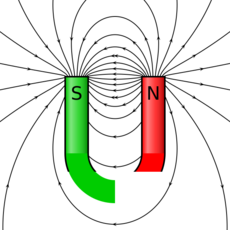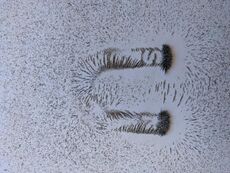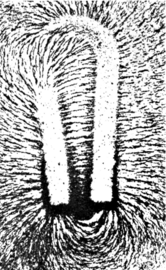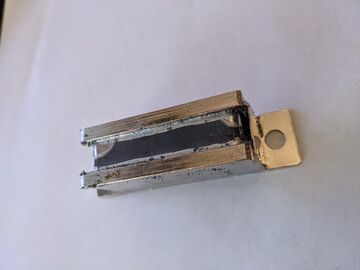Physics:Horseshoe magnet
| Part of a series of articles about |
| Electromagnetism |
|---|
 |
A horseshoe magnet is either a permanent magnet or an electromagnet made in the shape of a horseshoe (in other words, in a U-shape). The permanent kind has become the most widely recognized symbol for magnets.[1](p2) It is usually depicted as red and marked with 'North' and 'South' poles.[1](p3) Although rendered obsolete in the 1950s by squat, cylindrical magnets made of modern materials,[1](p3,467) horseshoe magnets are still regularly shown in elementary school textbooks.[1](p3) Historically, they were a solution to the problem of making a compact magnet that does not destroy itself in its own demagnetizing field.[1](p2)[2]
History
In 1819, it was discovered that passing electric current through a piece of metal deflected a compass needle. Following this discovery, many other experiments surrounding magnetism were attempted. These experiments culminated in William Sturgeon wrapping wire around a horseshoe-shaped piece of iron and running electric current through the wires creating the first horseshoe magnet.[3]
This was also the first practical electromagnet and the first magnet that could lift more mass than the magnet itself when the seven-ounce magnet was able to lift nine pounds of iron.[3][4] Sturgeon showed that he could regulate the magnetic field of his horseshoe magnet by increasing or decreasing the amount of current being run through the wires.[4] This would lay the groundwork for development of the electrical telegraph and the future of world-wide telecommunications for the next century and more.[4]
Shape
The shape of the magnet was originally created as a replacement for the bar magnet as it makes the magnet stronger.[5] A horseshoe magnet is stronger because both poles of the magnet are closer to each other and in the same plane which allows the magnetic lines of flux to flow along a more direct path between the poles and concentrates the magnetic field.[6]
The shape of the horseshoe magnet also drastically reduces its demagnetization over time.[7] This is due to coercivity also known as the "staying magnetized" ability of a given magnet.[7] Coercivity is weaker in disc or ring shapes, slightly stronger in cylinder or bar shapes, and strongest in horseshoe shapes.[6][7] To increase the coercivity of horseshoe magnets, steel keepers or magnet keepers are used.[7] A magnetic field holds its strength best when the entire magnetic field is given the ability to loop through a ferromagnetic substance instead of air.[8] The nearness of the horseshoe magnet’s poles facilitates the ability to use these magnet keepers more easily than other types of magnets.[8]
References
- ↑ 1.0 1.1 1.2 1.3 1.4 Coey, J. M. D. (2010) (in en). Magnetism and Magnetic Materials. Cambridge University Press. ISBN 978-0-511-67743-4. https://books.google.com/books?id=bqcgAwAAQBAJ&dq=%22making%20a%20reasonably%20compact%20magnet%20which%20will%20not%20destroy%20itself%20in%20its%20own%22&pg=PA2.
- ↑ "Why are Magnets Shaped like Horseshoes?" (in en). https://www.kjmagnetics.com/blog.asp?p=why-horseshoes.
- ↑ 3.0 3.1 "Magnetism and Electromagnetism". SPARK Museum of Electrical Invention. http://www.sparkmuseum.com/MAGNET.HTM#:~:text=In%201825%20William%20Sturgeon%20developed,horseshoe%2Dshaped%20piece%20of%20iron.&text=The%20seven%2Dounce%20magnet%20was,current%20from%20a%20single%20cell.
- ↑ 4.0 4.1 4.2 Bellis, Mary (23 February 2019). "William Sturgeon and the Invention of the Electromagnet". https://www.thoughtco.com/who-invented-the-electromagnet-1991678.
- ↑ "The Various Shapes of Magnets and Their Uses". https://www.apexmagnets.com/news-how-tos/the-various-shapes-of-magnets-and-their-uses/.
- ↑ 6.0 6.1 "Temperature and Neodymium Magnets". K&J Magnetics, Inc.. https://www.kjmagnetics.com/blog.asp?p=temperature-and-neodymium-magnets.
- ↑ 7.0 7.1 7.2 7.3 "Why are Magnets Shaped like Horseshoes?". K&J Magnetics, Inc.. https://www.kjmagnetics.com/blog.asp?p=why-horseshoes.
- ↑ 8.0 8.1 "Demagnetizing a Steel Nail". https://sciencing.com/demagnetizing-steel-nail-17841.html.
External links
 |








